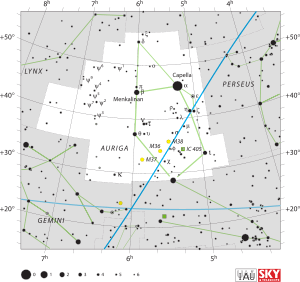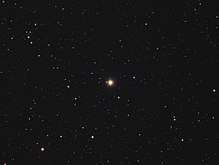Psi7 Aurigae
- For other star systems with this Bayer designation, see Psi Aurigae.
 | |
| Observation data Epoch J2000 Equinox J2000 | |
|---|---|
| Constellation | Auriga |
| Right ascension | 06h 50m 45.94330s[1] |
| Declination | +41° 46′ 52.4267″[1] |
| Apparent magnitude (V) | 5.02[2] |
| Characteristics | |
| Spectral type | K3 III[3] |
| U−B color index | +1.35[2] |
| B−V color index | +1.27[2] |
| R−I color index | 0.46 |
| Astrometry | |
| Radial velocity (Rv) | +59.53 ± 0.25[4] km/s |
| Proper motion (μ) | RA: –25.45[1] mas/yr Dec.: –138.19[1] mas/yr |
| Parallax (π) | 8.61 ± 0.22[1] mas |
| Distance | 379 ± 10 ly (116 ± 3 pc) |
| Absolute magnitude (MV) | −0.33[5] |
| Details | |
| Radius | 24[6] R☉ |
| Luminosity | 217[5] L☉ |
| Surface gravity (log g) | 2.35[7] cgs |
| Temperature | 4,300[7] K |
| Metallicity [Fe/H] | 0.00[7] dex |
| Rotational velocity (v sin i) | 10[8] km/s |
| Other designations | |
| Database references | |
| SIMBAD | data |

ψ7 Aurigae in optical light
Psi7 Aurigae, Latinized from ψ7 Aurigae, is the Bayer designation for a single[10] star in the northern constellation of Auriga. It is a dim, naked eye star with an apparent visual magnitude of 5.02.[2] Based upon parallax measurements made during the Hipparcos mission,[1] it is approximately 379 light-years (116 parsecs) distant from Earth.
This is an evolved giant star with a stellar classification of K3 III.[3] The measured angular diameter of this star, after correction for limb darkening, is 1.96 ± 0.04 mas.[11] At it estimated distance,[1] this yields a physical size of about 24 times the radius of the Sun.[6] The outer envelope shines with an effective temperature of 4,300,[7] giving it the orange-hued glow of a K-type star.[12]
References
- 1 2 3 4 5 6 7 van Leeuwen, Floor (November 2007), "Validation of the new Hipparcos reduction", Astronomy and Astrophysics, 474 (2): 653–664, arXiv:0708.1752v1, Bibcode:2007A&A...474..653V, doi:10.1051/0004-6361:20078357. Note: see VizieR catalogue I/311.
- 1 2 3 4 Johnson, H. L.; et al. (1966), "UBVRIJKL photometry of the bright stars", Communications of the Lunar and Planetary Laboratory, 4 (99), Bibcode:1966CoLPL...4...99J
- 1 2 Roman, Nancy G. (July 1952), "The Spectra of the Bright Stars of Types F5-K5", Astrophysical Journal, 116: 122, Bibcode:1952ApJ...116..122R, doi:10.1086/145598.
- ↑ Famaey, B.; et al. (January 2005), "Local kinematics of K and M giants from CORAVEL/Hipparcos/Tycho-2 data. Revisiting the concept of superclusters", Astronomy and Astrophysics, 430 (1): 165–186, arXiv:astro-ph/0409579, Bibcode:2005A&A...430..165F, doi:10.1051/0004-6361:20041272.
- 1 2 Anderson, E.; Francis, Ch. (2012), "XHIP: An extended hipparcos compilation", Astronomy Letters, 38 (5): 331, arXiv:1108.4971, Bibcode:2012AstL...38..331A, doi:10.1134/S1063773712050015.
- 1 2 Lang, Kenneth R. (2006), Astrophysical formulae, Astronomy and astrophysics library, 1 (3rd ed.), Birkhäuser, ISBN 3-540-29692-1
. The radius (R*) is given by:
- 1 2 3 4 McWilliam, Andrew (December 1990), "High-resolution spectroscopic survey of 671 GK giants. I - Stellar atmosphere parameters and abundances", Astrophysical Journal Supplement Series, 74: 1075–1128, Bibcode:1990ApJS...74.1075M, doi:10.1086/191527.
- ↑ Bernacca, P. L.; Perinotto, M. (1970), "A catalogue of stellar rotational velocities", Contributi Osservatorio Astronomico di Padova in Asiago, 239 (1), Bibcode:1970CoAsi.239....1B.
- ↑ "* 58 Aur". SIMBAD. Centre de données astronomiques de Strasbourg. Retrieved 2012-08-24.
- ↑ Eggleton, P. P.; Tokovinin, A. A. (September 2008), "A catalogue of multiplicity among bright stellar systems", Monthly Notices of the Royal Astronomical Society, 389 (2): 869–879, arXiv:0806.2878, Bibcode:2008MNRAS.389..869E, doi:10.1111/j.1365-2966.2008.13596.x.
- ↑ Richichi, A.; Percheron, I.; Khristoforova, M. (February 2005), "CHARM2: An updated Catalog of High Angular Resolution Measurements", Astronomy and Astrophysics, 431: 773–777, Bibcode:2005A&A...431..773R, doi:10.1051/0004-6361:20042039
- ↑ "The Colour of Stars", Australia Telescope, Outreach and Education, Commonwealth Scientific and Industrial Research Organisation, December 21, 2004, retrieved 2012-01-16.
External links
This article is issued from
Wikipedia.
The text is licensed under Creative Commons - Attribution - Sharealike.
Additional terms may apply for the media files.